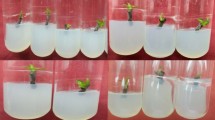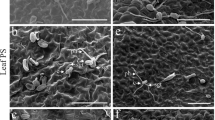Abstract
A disinfection procedure for mycorrhizal root segment surface was improved using neomycin and polymyxin B besides sodium hypochlorite, streptomycin and penicillin G, to obtain clean material for observation of proliferation of hyphae of arbuscular mycorrhizal (AM) fungi. The procedure of surface disinfection is more efficient, in terms of incidence of contamination, compared to the original procedure involving only sodium hypochlorite, streptomycin and penicillin G. A further decrease of visually detectable contamination can be achieved using bacteriostatic concentrations of rolitetracycline which cause a decrease of hyphal growth of the AM fungusGlomus fistulosum. The technique was used in experiment studying the uptake ofU-14C-glucose by proliferating hyphae. An active uptake of glucose occurred even in the presence of all four antibiotics at concentrations of 500 mg/L.
Similar content being viewed by others
References
Abbott L.K., Robson A.D., DeBoer G.: The effect of phosphorus on the formation of hyphae in soil by the vesicular-arbuscular mycorrhizal fungus.Glomus fasciculatum.New Phytol. 97, 437–446 (1984).
Barnová E., Barna K., Guzy J.: Peroxidative effects of tetracycline antibiotics.Čas. Lék. Čes. 130, 610–613 (1991).
Fréche C., Acar J.F.: Efficacité clinique d'Auricularum comparée à son eficacité bacteiologiquein vitro.Ann. Otolaryngol. Chir. Cervicofac. 105, 635–641 (1988).
Gryndler M., Hršelová H., Chvátalová I.: Effect of free-soil-inhabiting or root associated microfungi on the development of arbuscular mycorrhizae and on proliferation of intraradical mycorrhizal hyphae.Folia Microbiol. 41, 193–196 (1996).
Gryndler M., Veisadová H., Vančura V.: The effect of magnesium ions on the vesicular-arbuscular mycorrhizal infection of maize roots.New Phytol. 122, 455–460 (1992).
Gryndler M., Vosátka M.: The response ofGlomus fistulosum-maize mycorrhiza to treatments with culture fractions fromPseudomonas putida.Mycorrhiza 6, 207–211 (1996).
Hazenberg M.P., Pennock-Schroder A.M., Van der Merwe J.P.: Reversible binding of polymyxin B and neomycin to the solid part of faeces.J. Antimicrob. Chemother. 17, 333–339 (1986).
Hepper C.M., Jakobsen I.: Hyphal growth from spores of the mycorrhizal fungusGlomus caledonius: effect of amino acids.Soil Biol. Biochem. 15, 55–58 (1983).
Iskhakova K.: Antibiotic sensitivity of nonfermenting gram-negative bacteria.Antibiot. Khimoter. 33, 823–827 (1988).
Levina E.N., Kuznetsova S.M., Samoilova L.N., Speranskaia O.N., Sinitsina G.G.: Characteristics of the composition of the causative agents of different forms of suppurative inflammatory disease and their antibiotic sensitivity.Antibiot. Med. Biotekhnol. 30, 681–684 (1985).
Maris P.: Resistance aux antiseptiques et aux antibiotiques de 700 souches bacteriennes à gram negatif.Ann. Rech. Vet. 22, 11–23 (1991).
Mayo K., Davis R., Motta J.: Stimulation of germination of spores ofGlomus versiforme by spore-associated bacteria.Mycologia 78, 426–431 (1986).
Shachar-Hill Y., Pfeffer P.E., Douds D., Osman S.F., Doner L.W., Ratcliffe R.G.: Partitioning of intermediary carbon metabolism in vesicular arbuscular mycorrhizal leek.Plant Physiol. 108, 7–15 (1995).
Smart D.R., Ferro A., Ritchie C., Bugbee B.: On the use of antibiotics to reduce rhizoplane microbial populations in root physiology and ecology investigations.Physiol. Plant. 95, 533–540 (1995).
Strullu D.G., Romand C.: Methode d'obtention d'endomycorhizes à vesicules et arbuscules en conditions axéniques.C.R. Acad. Sci. Paris 303, 245–250 (1986).
Van der Vaaij D., Gaus W., Krieger D., Linzenmeyer G., Rozenberg-Arska M., De-Vries-Hospers H.G.: Bacteriological data on a prospective multicenter study of the effect of two different regimens for selective decontamination of patients with acute leukaemia.Infection 14, 268–274 (1986).
Williams P.G.: Disinfecting vesicular-arbuscular mycorrhizas.Mycol. Res. 94, 995–997 (1990).
Williams P.G.: Axenic culture of arbuscular mycorrhizal fungi, pp. 203–220 inMethods in Microbiology, Vol.24, chapter 11. Academic Press, San Diego 1992.
Author information
Authors and Affiliations
Rights and permissions
About this article
Cite this article
Gryndler, M., Hršelová, H. & Chivátalová, I. An improved procedure for root surface disinfection suitable for observations of proliferation of intraradical hyphae of arbuscular mycorrhizal fungusGlomus fistulosum . Folia Microbiol 42, 489–494 (1997). https://doi.org/10.1007/BF02826559
Received:
Revised:
Issue Date:
DOI: https://doi.org/10.1007/BF02826559




